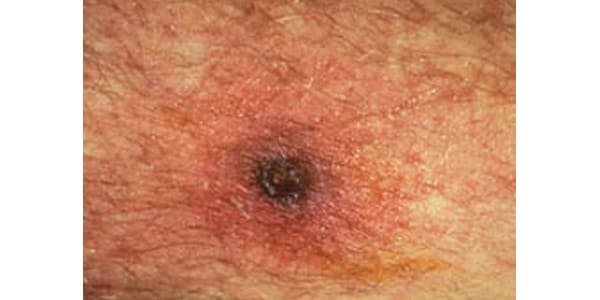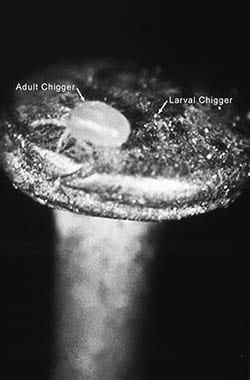Key points
- Scrub typhus is spread through bites of infected chiggers.
- Symptoms of scrub typhus include fever, chills, headache, body aches, a scab-like region at the chigger bite site (eschar), mental changes, enlarged lymph nodes, and rash.
- Scrub typhus is treated with doxycycline, which is most effective when administered early.
- Most cases of scrub typhus occur in rural areas of Southeast Asia, Indonesia, China, Japan, the Indian subcontinent, and northern Australia.

Overview
Scrub typhus, also known as bush typhus, is a disease caused by bacteria called Orientia tsutsugamushi. Scrub typhus is spread to people through bites of infected chiggers (larval mites). The most common symptoms of scrub typhus include fever, headache, body aches, and rash.
Most cases of scrub typhus occur in rural areas of Southeast Asia, Indonesia, China, Japan, the Indian subcontinent, and northern Australia. Anyone living in or traveling to areas where scrub typhus is found could get infected.
Signs and symptoms
Symptoms of scrub typhus usually begin within 10 days after infection. Signs and symptoms include:
- Fever and chills
- Headache
- Body aches and muscle pain
- A dark, scab-like region at the site of the chigger bite (also known as eschar)
- Mental changes, ranging from confusion to coma
- Enlarged lymph nodes
- Rash
If not treated appropriately, scrub typhus can be fatal and may lead to organ damage and severe bleeding.

Prevention
No vaccine is available to prevent scrub typhus. Reduce your risk of getting scrub typhus by avoiding contact with infected chiggers. When traveling to areas where scrub typhus is common, avoid areas with lots of vegetation and brush where chiggers may be found.
If you will be spending time outdoors:
- Use Environmental Protection Agency (EPA)-registered insect repellents containing DEET or other active ingredients registered for use against chiggers, on exposed skin and clothing.
- Always follow product instructions.
- Reapply insect repellent as directed.
- If you are also using sunscreen, apply sunscreen before applying insect repellent.
- Always follow product instructions.
- If you have a baby or child:
- Dress your child in clothing that covers arms and legs.
- Do not apply insect repellent onto a child's hands, eyes, or mouth or on cuts or irritated skin.
- Spray insect repellent onto your hands and then apply to child's face.
- Dress your child in clothing that covers arms and legs.
- Treat clothing and gear with 0.5% permethrin or purchase permethrin-treated items.
- Permethrin kills chiggers and can be used to treat boots, clothing, and camping gear.
- Treated clothing remains protective after multiple washings. See product information to learn how long the protection will last.
- If treating items yourself, follow the product instructions carefully.
- Do NOT use permethrin products directly on skin. They are intended to treat clothing.
- Permethrin kills chiggers and can be used to treat boots, clothing, and camping gear.

Testing and diagnosis
The symptoms of scrub typhus are similar to many other diseases. See your healthcare provider if you develop the symptoms listed above after spending time in areas where scrub typhus is found.
If you have recently traveled, tell your healthcare provider where and when you traveled.
Your healthcare provider may order blood tests to look for scrub typhus or other diseases.
Laboratory testing and reporting of results can take several weeks, so your healthcare provider may start treatment before results are available.
